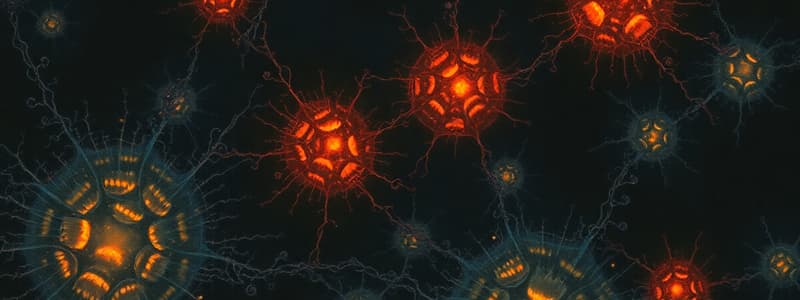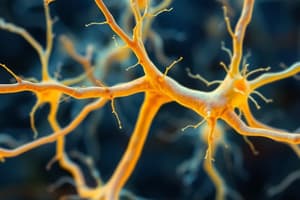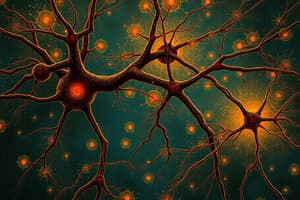Podcast
Questions and Answers
What is the role of oligodendrocytes in the central nervous system?
What is the role of oligodendrocytes in the central nervous system?
- They secrete neurotransmitters, facilitating communication between neurons.
- They myelinate axons, increasing the speed of signal transmission. (correct)
- They form the blood-brain barrier, preventing harmful substances from entering the brain.
- They act as immune cells, engulfing debris and pathogens.
Which type of neuronal connection allows multiple presynaptic neurons to influence a single postsynaptic neuron?
Which type of neuronal connection allows multiple presynaptic neurons to influence a single postsynaptic neuron?
- Synaptic transmission
- Divergence
- Convergence (correct)
- Axonal transport
What happens to the motor neuron responsible for the flexor muscle during the knee-jerk reflex?
What happens to the motor neuron responsible for the flexor muscle during the knee-jerk reflex?
- It receives signals from both the sensory and motor neurons, resulting in a balanced response.
- It is excited by the sensory neuron, causing the flexor muscle to contract.
- It remains inactive, as the flexor muscle is not involved in the reflex.
- It is inhibited by the interneuron, causing the flexor muscle to relax. (correct)
What is the function of the neuropil in a neural circuit?
What is the function of the neuropil in a neural circuit?
What is the role of astrocytes in the central nervous system?
What is the role of astrocytes in the central nervous system?
Which of the following is NOT a characteristic of a typical sensory neuron in the knee-jerk reflex?
Which of the following is NOT a characteristic of a typical sensory neuron in the knee-jerk reflex?
What is the primary function of Schwann cells in the peripheral nervous system?
What is the primary function of Schwann cells in the peripheral nervous system?
Which of the following is NOT a component of a typical neural circuit?
Which of the following is NOT a component of a typical neural circuit?
Which of the following is NOT a characteristic of dendrites?
Which of the following is NOT a characteristic of dendrites?
What is the primary function of the myelin sheath?
What is the primary function of the myelin sheath?
Where are the Nodes of Ranvier located?
Where are the Nodes of Ranvier located?
Which type of glial cell produces myelin in the peripheral nervous system (PNS)?
Which type of glial cell produces myelin in the peripheral nervous system (PNS)?
What is the role of the synaptic cleft in neuronal communication?
What is the role of the synaptic cleft in neuronal communication?
Which of the following is NOT directly involved in the process of neurotransmitter release?
Which of the following is NOT directly involved in the process of neurotransmitter release?
What is the primary function of the cell body (soma) of a neuron?
What is the primary function of the cell body (soma) of a neuron?
Which of the following statements correctly describes the relationship between neurons and glial cells?
Which of the following statements correctly describes the relationship between neurons and glial cells?
What technique is used to investigate the direction of information flow within a neural system?
What technique is used to investigate the direction of information flow within a neural system?
Which of the following techniques is used to visualize the expression of specific genes?
Which of the following techniques is used to visualize the expression of specific genes?
What technique is used to detect and localize proteins of interest?
What technique is used to detect and localize proteins of interest?
Which technique involves the binding of an mRNA to a complementary DNA sequence?
Which technique involves the binding of an mRNA to a complementary DNA sequence?
Which of the following is NOT part of the Central Nervous System (CNS)?
Which of the following is NOT part of the Central Nervous System (CNS)?
What is the role of the Peripheral Nervous System (PNS)?
What is the role of the Peripheral Nervous System (PNS)?
Which of the following is the correct order of signal direction in the nervous system?
Which of the following is the correct order of signal direction in the nervous system?
What percentage of human genes are expressed exclusively in the brain?
What percentage of human genes are expressed exclusively in the brain?
What is the role of the ASPM gene in brain development?
What is the role of the ASPM gene in brain development?
Which of the following model organisms has the highest number of genes?
Which of the following model organisms has the highest number of genes?
What is the main goal of knock-in/knockout models in genetic engineering?
What is the main goal of knock-in/knockout models in genetic engineering?
What is the role of Cre recombinase in the Cre-LoxP system?
What is the role of Cre recombinase in the Cre-LoxP system?
What is a floxed gene?
What is a floxed gene?
How does the Cre-LoxP system disrupt the function of the androgen receptor gene in nervous system cells?
How does the Cre-LoxP system disrupt the function of the androgen receptor gene in nervous system cells?
What is the main function of Cas9 in the CRISPR-Cas9 system?
What is the main function of Cas9 in the CRISPR-Cas9 system?
Which of the following is NOT a potential outcome of the CRISPR-Cas9 system?
Which of the following is NOT a potential outcome of the CRISPR-Cas9 system?
Which of the following repair mechanisms can introduce unintended mutations?
Which of the following repair mechanisms can introduce unintended mutations?
What happens to a motor neuron (flexor) when it is inhibited by an interneuron?
What happens to a motor neuron (flexor) when it is inhibited by an interneuron?
Which of the following best describes the role of calcium-sensitive dyes in calcium imaging?
Which of the following best describes the role of calcium-sensitive dyes in calcium imaging?
Which of these techniques allows for precise control of neural circuits by using light-sensitive proteins?
Which of these techniques allows for precise control of neural circuits by using light-sensitive proteins?
Which type of opsin allows for the stimulation of neurons when exposed to blue light?
Which type of opsin allows for the stimulation of neurons when exposed to blue light?
What is the effect of hyperpolarization on a neuron?
What is the effect of hyperpolarization on a neuron?
How do Halorhodopsins inhibit neuronal activity?
How do Halorhodopsins inhibit neuronal activity?
In calcium imaging, what does the change in calcium release correlate with?
In calcium imaging, what does the change in calcium release correlate with?
Which of these is NOT a key feature of optogenetics?
Which of these is NOT a key feature of optogenetics?
Flashcards
Nervous System
Nervous System
A complex network of neurons and glial cells that transmit signals and provide support.
Neurons
Neurons
The primary signaling units of the nervous system that transmit signals between different parts of the body.
Glial Cells
Glial Cells
Supportive cells in the nervous system that provide protection, nourishment, and support to neurons.
Dendrites
Dendrites
Signup and view all the flashcards
Cell Body (Soma)
Cell Body (Soma)
Signup and view all the flashcards
Axon
Axon
Signup and view all the flashcards
Myelin Sheath
Myelin Sheath
Signup and view all the flashcards
Synapse
Synapse
Signup and view all the flashcards
Neuromuscular Junction
Neuromuscular Junction
Signup and view all the flashcards
Divergence
Divergence
Signup and view all the flashcards
Convergence
Convergence
Signup and view all the flashcards
Astrocytes
Astrocytes
Signup and view all the flashcards
Oligodendrocytes
Oligodendrocytes
Signup and view all the flashcards
Schwann Cells
Schwann Cells
Signup and view all the flashcards
Afferent Neurons
Afferent Neurons
Signup and view all the flashcards
Knee-Jerk Reflex
Knee-Jerk Reflex
Signup and view all the flashcards
Depolarization
Depolarization
Signup and view all the flashcards
Repolarization
Repolarization
Signup and view all the flashcards
Interneuron
Interneuron
Signup and view all the flashcards
Calcium Imaging
Calcium Imaging
Signup and view all the flashcards
Optogenetics
Optogenetics
Signup and view all the flashcards
Channelrhodopsins
Channelrhodopsins
Signup and view all the flashcards
Halorhodopsins
Halorhodopsins
Signup and view all the flashcards
Neuronal Activity Applications
Neuronal Activity Applications
Signup and view all the flashcards
Striatum
Striatum
Signup and view all the flashcards
Substantia nigra
Substantia nigra
Signup and view all the flashcards
Lesion studies
Lesion studies
Signup and view all the flashcards
Transgenic reporters
Transgenic reporters
Signup and view all the flashcards
Antibody labeling
Antibody labeling
Signup and view all the flashcards
In situ hybridization
In situ hybridization
Signup and view all the flashcards
Central Nervous System (CNS)
Central Nervous System (CNS)
Signup and view all the flashcards
Peripheral Nervous System (PNS)
Peripheral Nervous System (PNS)
Signup and view all the flashcards
Genomics
Genomics
Signup and view all the flashcards
Knock-in/Knock-out Models
Knock-in/Knock-out Models
Signup and view all the flashcards
Cre-LoxP System
Cre-LoxP System
Signup and view all the flashcards
CRISPR-Cas9
CRISPR-Cas9
Signup and view all the flashcards
Cas9
Cas9
Signup and view all the flashcards
Guide RNA (gRNA)
Guide RNA (gRNA)
Signup and view all the flashcards
Homology-directed repair
Homology-directed repair
Signup and view all the flashcards
Study Notes
Nervous System Overview
- The nervous system is comprised of neurons and glial cells
- Neurons transmit signals; glial cells provide support
- Neurons are the primary signaling units
Neuron Structure
- Dendrites: Highly branched extensions receiving signals from other neurons; contain neurotransmitter receptors
- Cell Body (Soma): Contains the nucleus and organelles; site of protein synthesis
- Axon: Single, long extension transmitting action potentials to other neurons or target cells; can be myelinated or unmyelinated
- Myelin Sheath: Insulates axons, speeds up signal transmission; produced by oligodendrocytes (CNS) and Schwann cells (PNS)
- Nodes of Ranvier: Unmyelinated gaps in the myelin sheath increasing signal speed through saltatory conduction
Synapses
- Synapses are the sites where neurons communicate
- Presynaptic terminal (terminal bouton): Releases neurotransmitters stored in vesicles
- Synaptic cleft: The space between neurons where neurotransmitters diffuse
- Postsynaptic terminal: Contains receptors that bind neurotransmitters
Glial Cells
- Support and regulate the function of neurons
- Astrocytes: Maintain blood-brain barrier, regulate ion and neurotransmitter concentrations, secrete chemicals essential for synaptogenesis
- Oligodendrocytes: Myelinate axons in the CNS
- Microglia: Act as the immune cells of the CNS
- Schwann Cells: Myelinate axons in the PNS
Signal Transmission
- Neurons are polarized (distinct input/output regions)
- Proteins and organelles move along axons via microtubules
- Signal types include excitatory, inhibitory, and modulatory (depending on the neurotransmitter)
Neuronal Circuits
- Afferent neurons carry sensory information toward the CNS
- Efferent neurons carry motor commands away from the CNS
- Interneurons facilitate local processing in circuits
Neural Circuit Example: Knee-Jerk Reflex
- Sensory neurons detect stimulus
- Sensory neurons synapse with and excite motor neurons in the spinal cord
- Interneurons synapse to inhibit motor neurons of opposing muscles
- Motor neurons trigger muscle contraction (extension)
Techniques for Studying Neural Activity
- Calcium Imaging: Calcium-sensitive dyes used to monitor neuronal activity
- Optogenetics: Using light to control neuronal activity via light-sensitive proteins (opsins)
Structural Analysis of Neural Systems
- Lesion studies: Damage specific brain areas to study information flow
- Labeling proteins: Visualize gene expression and areas of activity
Organization of the Nervous System
- Central Nervous System (CNS): Brain and spinal cord (processing sensory input, generating motor output)
- Peripheral Nervous System (PNS): Connects the CNS to the body (sensory and motor pathways)
Genomics and the Nervous System
- Genomics: Analysis of complete DNA sequences
- Role of the Genome: Human genome has genes regulating brain organization and function; a significant proportion expressed exclusively in the brain
- Model Organisms: Used to study neural systems. Examples include humans, mice, zebrafish, fruit flies, and nematodes
Genetic Engineering Techniques
- Knock-in/Knock-out Models: Modify specific genes in organisms to study their effects
- Cre-LoxP System: Alter specific DNA regions in controlled manner, typically in mice; used to control gene expression
CRISPR-Cas9 System
- Components: Cas9 endonuclease and guide RNA
- Process: The CRISPR-Cas9 system is used to modify specific DNA regions by introducing double-stranded breaks
- This allows for: inducing mutations, insertions, or deletions facilitating gene function studies and creating animal models of diseases
Studying That Suits You
Use AI to generate personalized quizzes and flashcards to suit your learning preferences.




